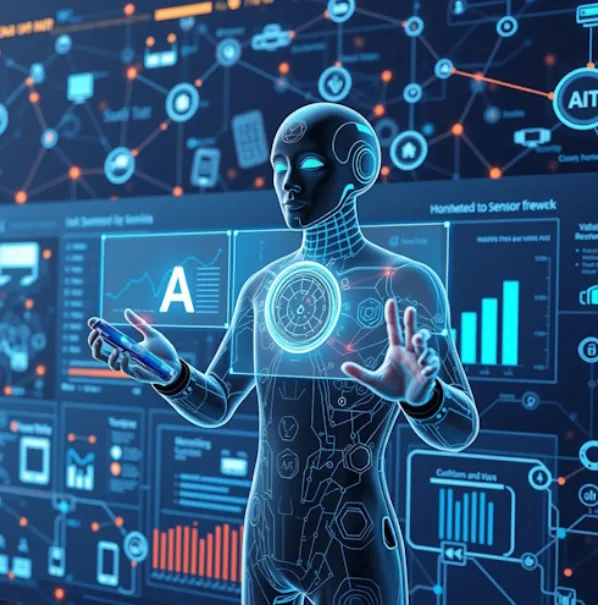In industries ranging from manufacturing plants to energy facilities, sensors are becoming an integral part of daily operations. These sensors capture every small detail, from temperature fluctuations to vibrations, forming a massive stream of data. However, the challenge for many organizations is not the lack of data but the overwhelming surplus of it. In this post, we explore how companies can transform this raw data into actionable insights with the help of Artificial Intelligence (AI), leading to improved decision-making, enhanced performance, and reduced risks.
Navigating the Data Deluge
The Internet of Things (IoT) has found its way into various industries, from car assembly lines to wind farms and construction sites. Modern machines come equipped with sensors to measure energy usage, pressure changes, and much more. As a result, organizations can track real-time data across entire facilities, but the influx of data is often more of a challenge than an advantage. The question remains: how can companies make sense of terabytes of sensor data?
In most cases, businesses invest heavily in monitoring systems, but without an effective process for analyzing the data, much of it goes underutilized. This data often ends up locked away in databases, leaving companies with critical unanswered questions, such as: Is equipment on the verge of failure? Do temperature spikes indicate a compliance issue? Or is the system performing as efficiently as expected? With no clear strategy to process and interpret the data, the information stays dormant.
The Limitations of Raw Data
Unprocessed data can be difficult to interpret. Data points often appear disconnected and lacking context, which makes it challenging to make informed decisions. For example, a motor might register an unexpected vibration, but without additional information like service history, load, or environmental factors, it’s hard to determine its significance. As a result, many companies continue to rely on scheduled maintenance rather than real-time insights.
Raw data, no matter how abundant, is only valuable when it is properly organized, contextualized, and analyzed. This is where AI comes into play.
AI: The Key to Unlocking Actionable Insights
Artificial Intelligence plays a pivotal role in transforming raw data into valuable guidance. What would take humans days or even weeks to analyze, AI can accomplish in seconds. With the use of machine learning, predictive analytics, and anomaly detection, AI is able to uncover patterns that would remain hidden otherwise.
Here are a few examples of how AI can turn IoT data into meaningful insights:
- A slight vibration detected by sensors could indicate an impending bearing failure.
- Unusual sensor behavior could be cross-referenced with past records to predict potential risks.
- Critical events can be prioritized based on urgency and potential impact.
- Instead of a flood of alarms, teams receive clear, actionable recommendations.
AI doesn’t replace the expertise of engineers or technicians; it enhances it. By filtering out irrelevant signals, highlighting key indicators, and providing context, AI helps make quicker and more reliable decisions.
Shifting from Reactive to Proactive Decision-Making
Traditionally, many organizations have operated on a reactive approach: responding only when something goes wrong. A machine breaks down, a compliance issue is discovered, or an accident occurs. This approach is not only slow but also costly. Downtime, compliance violations, and safety risks can all escalate unexpectedly.
AI changes this paradigm by enabling organizations to identify potential problems before they escalate into significant issues. Instead of reacting to failures, businesses can prevent them from happening in the first place. This shift allows for proactive decision-making that leads to better outcomes.
Here are a few examples of proactive changes enabled by AI:
- Identifying component wear and tear long before failure occurs.
- Analyzing historical audit data to predict future compliance risks.
- Detecting processes that are drifting from set thresholds and addressing them before they deviate further.
The result is fewer disruptions, better control, and more efficient operations.
Turning IoT Data into Actionable Decisions
Converting raw data into actionable insights requires more than just advanced algorithms; it requires a structured process. Here’s how organizations can successfully unlock the value of IoT data:
- Data Collection: Gather sensor outputs, machine logs, and inspection notes in a centralized system.
- Data Cleaning: Eliminate irregularities, fill in missing data points, and standardize formats.
- Adding Context: Layer operational settings, maintenance histories, and quality standards onto the raw data.
- AI Analysis: Use algorithms to detect trends, spot anomalies, and identify predictive signals.
- Delivering Results: Present the findings in a usable format, such as dashboards, reports, or alerts, which are then integrated into existing workflows to inform daily decisions.
Each of these stages relies on the others, and any missing link can distort the final outcome. To ensure accuracy, companies must approach this process methodically.
Overcoming Barriers to AI Adoption
While the benefits of AI-driven IoT insights are clear, many companies still struggle to fully leverage these technologies. Some of the common obstacles include:
- Disconnected Systems: Information is often trapped in isolated databases that don’t communicate with one another.
- Inconsistent Data Structures: Data arrives in various formats, making it difficult to analyze automatically.
- Overload of Alerts: A constant stream of unorganized signals can overwhelm rather than inform teams.
- Cultural Resistance: Employees accustomed to manual processes may be hesitant to trust AI-driven recommendations.
To overcome these challenges, businesses must adopt a clear change management strategy. This includes providing training, fostering a culture of openness, and demonstrating the practical benefits of AI to build trust and ensure successful implementation.
From Insights to Action: Making IoT Data Work for You
Turning IoT data into something that directly impacts daily operations is not always a straightforward process. At times, the signal may arrive too late, or it might get lost in the noise. However, when AI is used to sift through this data and extract meaningful insights, the results can be transformative.
By detecting potential issues early, AI helps improve equipment lifespan, streamline audits, and enhance safety. The key takeaway here is not simply about collecting more data, but about recognizing patterns and aligning those insights with tangible operational goals. Over time, AI-powered systems can evolve from passive data recorders to active participants in optimizing operations.
In conclusion, AI-driven IoT systems represent a powerful tool for organizations aiming to move from reactive problem-solving to proactive decision-making. With the right processes in place, these technologies can unlock new levels of efficiency, reliability, and safety, ultimately helping companies achieve their strategic objectives.







